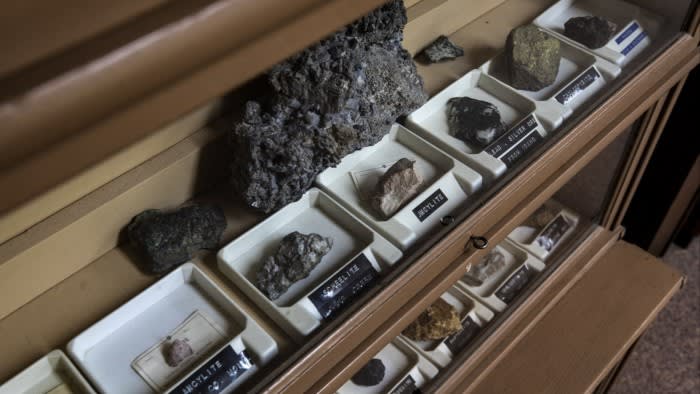This article is an on-site version of our Energy Source newsletter. Premium subscribers can sign up here to get the newsletter delivered every Tuesday and Thursday. Standard subscribers can upgrade to Premium here, or explore all FT newsletters
Good morning, and welcome to Energy Source, coming to you today from London.
One big story this month is how Big Tech has stepped in to bolster nuclear power — a trend that has sent nuclear energy stocks to record highs, as my colleagues Jamie Smyth and Amanda Chu cover here.
If you want to understand why record numbers of businesses are expected to attend this week’s UN conference on biodiversity in Colombia, don’t miss Susannah Savage’s Big Read here.
Today’s Energy Source is about the Minerals Security Partnership, the US-led effort to create critical mineral supply chains outside of China (and why that’s hard to do).
This week, a lot of the FT energy team will be at the Energy Transition Summit, featuring speakers including National Grid chief executive John Pettigrew, and Centrica boss Chris O’Shea. You can register and watch along here — it starts today.
Thanks for reading,
Leslie
Minerals Security Partnership adds rare earths project in Brazil
The US Department of State gave its backing to a new rare earths project in Brazil on Monday, the latest plan to get support from the Minerals Security Partnership.
The US-led MSP, which includes 14 countries and the EU, is supposed to be the west’s answer to China’s control of critical minerals and rare earths.
China dominates the processing for many minerals that are critical to defence and the energy transition, and MSP’s goal is to develop supply chains for those minerals outside of Chinese influence.
The latest MSP-backed project, the Pela Ema deposit operated by Serra Verde Group, is an example of how the coalition works — but also shows how far the initiative has to go before it can successfully replicate critical mineral supply chains.
The Swiss-based company on Monday announced a successful $150mn fundraising from three well-known mining investors: Boston’s Denham Capital; the Energy and Minerals Group of Houston; and Vision Blue, the fund led by former Xstrata chief executive Sir Mick Davis.
The US state department said: “This investment is a powerful demonstration of the Minerals Security Partnership’s role in establishing sustainable, secure and diversified supply chains.”
But unlike China, the MSP does not have its own pool of funding for the projects — all it can do is encourage private capital and state-backed funders such as the US International Development Finance Corporation and Natural Resources Canada to support projects that are presented to the group.
Since it was founded two years ago, the MSP has supported more than a dozen projects for elements including graphite, rare earth and nickel.
At present the rare earths produced by Serra Verde are all sent to China for processing.
North America and Europe have several heavy rare earths processing facilities under construction, but China is the only place in the world that can process the kind of heavy rare earths produced by Serra Verde’s mine.
Serra Verde’s mine in the Brazilian state of Goiás produces rare earths from ionic clay, including minerals key for permanent magnets used in electric vehicles and wind turbines — such as neodymium, praseodymium, terbium and dysprosium. Commercial production began earlier this year, and it is the only active producer of heavy rare earths outside of China, according to the company.
The advantage of extracting rare earths from clay, rather than from hard rock, is that it is easier to process and does not require crushing, the company said.
China is the largest miner of ionic clay rare earths. It produces 60 per cent of the world’s rare earths and processes 90 per cent.
Thras Moraitis, chief executive of Serra Verde, said the new funds raised would “allow us to get to a scale so that we stand on our own two feet and compete economically”.
Because of China’s ability to produce low-cost rare earths, which keeps prices down, it is difficult for new entrants to break into the market.
Gracelin Baskaran, director of the critical minerals security programme at the Center for Strategic and International Studies, said the MSP’s support for Serra Verde is part of a broader rapprochement between the US and Brazil. Earlier this year, the IDFC opened up its first office in Latin America in São Paulo.
“Brazil has significant rare earth reserves and they are very untapped. They have about 18 per cent of the worlds’ rare earths reserves, but they produce less than half a per cent,” said Baskaran. “So if you want to look at rare earth’s potential, it really sits in Brazil.” (Leslie Hook)
Power Points
Energy Source is written and edited by Jamie Smyth, Myles McCormick, Amanda Chu, Tom Wilson and Malcolm Moore, with support from the FT’s global team of reporters. Reach us at energy.source@ft.com and follow us on X at @FTEnergy. Catch up on past editions of the newsletter here.
Recommended newsletters for you
Moral Money — Our unmissable newsletter on socially responsible business, sustainable finance and more. Sign up here
The Climate Graphic: Explained — Understanding the most important climate data of the week. Sign up here
https://www.ft.com/content/8a4d0e7a-d207-4759-908c-66940a100cc3


